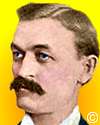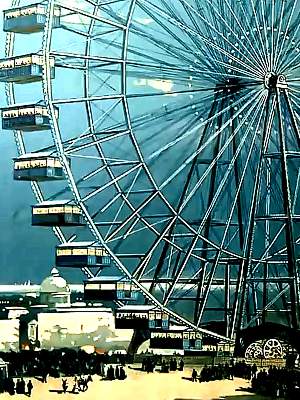 (source)
(source)
|
George Ferris
(14 Feb 1859 - 22 Nov 1896)
American engineer and inventor who invented the giant observation wheel for the World’s Columbian Exposition, Chicago, Illinois (1893).
|
LIGHTING OF THE FERRIS WHEEL.
from Electricity at the Columbian Exposition (1894)
[p.19] It was not originally contemplated to light the wheel, the intention being merely to light the offices, border and fences and illuminate the supporting pillars. Later, however, during the progress of wiring, it was thought better to extend the plant and illuminate the wheel also. All of the lamps on the iron work were set as nearly as possible eighteen inches apart and were all placed upon porcelain bases which in turn were screwed to a wooden block, this being bolted to the iron structure. All of these blocks, also all of the unglazed porcelain surfaces were thoroughly painted with P and B insulating compound. The illumination of the wheel proper [p.20] consisted of two outer circles, one on each side, 250 feet in diameter, carrying 360 lamps in twelve circuits; each circuit being protected by a double pole safety cut-out of porcelain. Within these were two circles of 170 feet diameter carrying 200 lamps each and connected to the outer circle by twelve radial arms—six on each side. In addition to these there was a large star near the axle on each side and a spiral of lamps around the axle, together using 210 lamps. It will thus be seen that there had to be taken off from the two collector rings current sufficient for 1,540 16-c.p. Edison incandescent lamps at 110 volt. These two rings were made of solid copper fifty-six inches in diameter, five-eighths of an inch thick and three inches wide, each placed upon an insulating collar. The brushes used allowed the wheel to revolve in either direction for the purpose of taking up the wear on the gears. An elliptical form was therefore selected one and one-fourth inches wide built up of fifty sheets of No. 36 copper wound first in a ring and screwed and soldered to the brush holders. Connection from the two 0000 mains was made to the brush holder by two compression rings, which slipped over the stud inside of the block which held the brush holders. The lamps were placed at an angle of 45 degrees just within the outer rim of the wheel as from there they were entirely invisible from the carriages and still cleared the supporting towers which were but two inches from the iron rim and could be seen when one was directly in front of the wheel. The lamp was attached to the porcelain base which in turn was fastened to the circular wood block which was secured to the ironwork by screwing on to the projection of the bolts that held the angle plates together. All of the wire on the ironwork was of the best quality “Okonite” or “Simplex” protected at angles of the iron, and other places where abrasion was likely to occur, by insulating conduit or tape. All joints were carefully made, soldered, wiped and thoroughly taped with Okonite and smeared with P and B compound. The whole line tested free from ground upon completion and remained so with the exception of short repair intervals. All of the special fittings were made and all wiring done by the Western Electric Company of Chicago. In addition to the wheel, the two supporting pillars composed of four stanchions each, were illuminated from the ground up, culminating at the axle in the star cluster before mentioned. In addition, the connecting arches at the bottom had each two rows of lamps and three braces at equal intervals up the pillar, and were lighted, giving the whole a more solid appearance. The same care was taken in wiring these supports as in the wheel proper.
The fences, garden and offices were also illuminated, adding very much to the effect when one was near the wheel. This swells the total number of lamps to 2,900 16-c.p. incandescent lamps. The central [p.21] station supplying current for these lamps, was placed outside of the ground at a distance of 700 feet and was carried by several Okonite cables as follows: four 000, two 00, one 0 from the generators to the terminal house, from which it was distributed over offices, fences and pillars and current for the wheel was carried by two 0000 cables up one of the pillars to the collector rings. These seven cables were bunched together and run in a box made of rough white pine boards one inch by six inches and returned in an adjacent similar box. These boxes were not painted or protected in any manner from the damp swampy soil through which they were laid and run throughout their length within twelve inches of the steam pipe supplying the driving engines. This pipe was covered with mineral wool and an out-covering of cement.
The machines supplying this current were two Edison machines giving 200 amperes at 110 volts each and two Western Electric machines giving 400 amperes at 110 volts each. Each pair of machines was belted in tandem with a double expansion 125-h.p. Dick & Church engine, the Edison machines being run at a speed of 1,300 and Western Electric at 900 revolutions per minute. On the switchboard each machine was supplied independently with an ammeter starting box and switch. Each pair was also equalized by bus-bars at the fuse blocks and furnished with a voltmeter. The instruments in connection with each pair of machines being of same manufacture as machine. The fuses were all placed upon slate bases at the back of board and well ventilated cables were connected directly to the fuse blocks and entered conduit immediately under the switchboard. An extra switch was placed before the completion of the wheel wiring so that the Western Electric machines might be used to light the pillars in the event of a mishap to the General Electric machines installed for that purpose. The Western Electric machines were used for the illumination of the wheel and those of the General Electric Company to light the offices, grounds and pillars supporting the wheel.
There were three 250-h.p. Heine boilers delivering steam at 100 lbs., pressure. Two of these were in constant use and supplied motive power for the wheel, the other being used for the operation of the lighting plant.
The fuel used was oil taken from the same mains that supplied the Exposition power plant.
The whole electric plant gave entire satisfaction and probably served better to advertise and make the wheel an evening attraction than anything else, and illustrated one more feature of this gigantic Exposition in which electricity played a most important part as an agent of ornamentation as well as a motive power and means of illumination.
- 14 Feb - short biography, births, deaths and events on date of Ferris's birth.
- Ferris Wheel - from Report of the Committee on Awards of World's Columbian Commission (1901).
- 21 Jun - short biography, births, deaths and events on date of Opening the Ferris Wheel.
- Circles in the Sky the Life and Times of George Ferris, by Richard Weingardt. - book suggestion.
- Booklist for Ferris Wheel.





